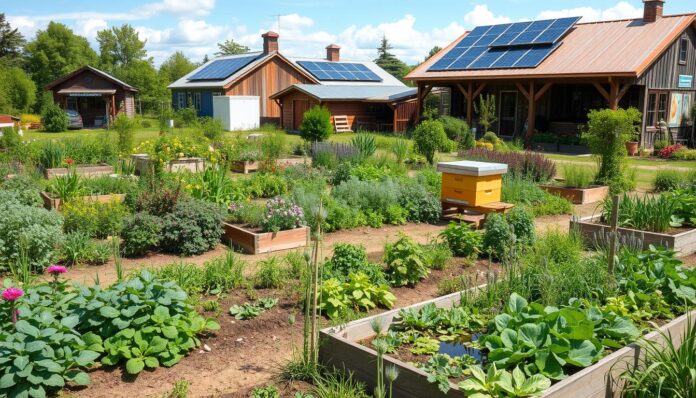Creating a thriving permaculture business is more than just making money. It’s about making a difference for the future. As more people want organic and naturally-grown products, there’s a big chance for entrepreneurs. By using permaculture trends, businesses can grow in the organic market and last longer.
Experts say a profitable permaculture business is key for farms or ranches to thrive. It’s about being sustainable, keeping the environment safe, and connecting with the community. By keeping up with permaculture trends, like switching to permaculture, businesses can cut down on waste and make more money. Organic products are in high demand, which means good profits for those who offer them.
Key Takeaways
- Permaculture business models can generate significant profits while contributing to a sustainable future
- Understanding permaculture trends is crucial for capitalizing on the growing demand for organic products
- Permaculture market analysis can help businesses identify opportunities for growth and improvement
- Transitioning to permaculture practices can reduce environmental footprint and improve financial returns
- Consistency in quality and produce grading is essential for branding products and establishing relationships with specialty distributors
- Financial planning should realistically assess income generation through products or services
Understanding Permaculture Fundamentals
Permaculture is a farming method that links land, resources, people, and the environment. It creates a sustainable system, like natural ecosystems. The sustainable agriculture market research shows it can change how we grow food and interact with nature.
This method aims to use land and resources without waste. It seeks closed loop systems, which is key in agriculture. By using permaculture, farmers can cut down on chemicals, save water, and boost biodiversity. This aligns with the regenerative farming industry analysis, stressing the need for sustainable farming.
What is Permaculture?
Permaculture is a design system for a permanent, regenerative culture. It involves observing and working with the environment. By applying permaculture principles, we can build a more sustainable food system.
Principles of Permaculture Design
The design principles of permaculture include observing and working with the environment. They also involve catching and storing energy, getting a yield, and using self-regulation and feedback. These principles aim to create a sustainable system that works with nature.
Benefits of Adopting Permaculture Practices
Adopting permaculture practices offers many benefits. It improves soil health, boosts biodiversity, and enhances ecosystem services. Permaculture also helps reduce pollution, fight climate change, and support local food systems. By embracing permaculture, we can build a more sustainable food system that benefits everyone and the environment.
Key Characteristics of a Successful Permaculture Business Model
A successful permaculture business model is resilient and sustainable. It thrives in the changing eco-friendly market. It does this by diversifying, selling products, offering services, and making value-added products. Recent eco-friendly market analysis shows that permaculture businesses with sustainable practices grow steadily.
Some key traits of a successful permaculture business model are:
- Climate adaptation strategies, like using renewable resources and reducing waste
- Economic viability, achieved through efficient resource use and minimal debt
- Resilience and sustainability, ensured through diversification and strategic planning
By adopting these traits, permaculture businesses can succeed and help create a sustainable future. As more people seek eco-friendly products and services, permaculture market growth will likely increase. This makes it a promising field for investors and entrepreneurs.

By doing thorough eco-friendly market analysis and understanding permaculture, businesses can develop effective strategies. This helps them thrive in the growing market.
| Characteristics | Benefits |
|---|---|
| Climate adaptation strategies | Reduced risk, increased resilience |
| Economic viability | Increased profitability, reduced debt |
| Resilience and sustainability | Long-term success, environmental benefits |
Creating a Permaculture Business Plan
Creating a permaculture business plan is a big step. It starts with knowing your target market and setting clear goals. It’s important to understand the organic farming industry insights and green economy market trends. This helps make smart choices.
Looking at what people want and who you’re up against is key. A good plan also needs financial forecasts and ways to get funding. This could be through grants, loans, or investors who back green economy market trends and sustainable farming.
- Conducting market research to understand consumer needs and preferences
- Developing a unique value proposition that sets the business apart from competitors
- Creating a comprehensive financial plan, including budgeting and funding strategies
By following these steps and keeping up with organic farming industry insights and green economy market trends, you can build a successful permaculture business. This business will help make the future more sustainable.
Developing Sustainable Products and Services
The global market for sustainable products is expected to hit $150 billion by 2025. Permaculture businesses can make the most of this by creating new, eco-friendly products and services. A permaculture market analysis can show where to grow and expand. Also, sustainable agriculture market research gives insights into what customers want.
Examples of sustainable products and services include organic food, artisanal goods, and green gardening tools. A sustainable agriculture market research helps permaculture businesses understand what’s in demand. This way, they can create products and services that fit the growing need for green options.

By offering different products and services, permaculture businesses can make more money and stand out. This could be through workshops, consulting, or educational programs on permaculture and green living.
Recent stats show 63% of people are ready to spend more on green products. This shows a big chance for permaculture businesses to enter this market. By doing a deep permaculture market analysis and keeping up with sustainable agriculture market research, they can create profitable, innovative products and services.
Implementing Eco-Friendly Practices
The world is turning to sustainable and regenerative agriculture more than ever. Eco-friendly practices in permaculture are key. They can save costs and boost crop yields. Eco-friendly farming cuts emissions by 50% and improves soil health, reducing erosion by up to 90%.
Some important strategies for eco-friendly permaculture include:
- Sourcing sustainable materials for farming and construction
- Reducing waste in the supply chain through efficient operations and resource management
- Improving energy efficiency in operations through the use of renewable energy sources and precision agriculture
An eco-friendly market analysis helps permaculture businesses grow. By going green, they can cut down on environmental harm and increase profits. As more people look for eco-friendly products, the need for sustainable farming will keep rising.
By adopting eco-friendly practices, permaculture businesses can thrive. They should keep up with the latest in regenerative farming and eco-friendly market analysis. This way, they can succeed in a market that’s always changing.
| Practice | Benefits |
|---|---|
| Sourcing sustainable materials | Reduced waste, improved resource efficiency |
| Reducing waste in the supply chain | Cost savings, improved operational efficiency |
| Improving energy efficiency | Reduced emissions, improved crop yields |
Marketing Your Permaculture Business
To succeed in the permaculture market, it’s key to keep up with trends and understand market growth. You need a strong online presence, use digital marketing, and build a personal brand. This helps you stand out and grow your business.
Marketing a permaculture business well means telling a compelling brand story and using digital marketing. It also involves connecting with local communities. These steps help increase your visibility, draw in new customers, and keep you competitive in the growing market.
Key strategies for marketing a permaculture business include:
- Creating valuable content, like blog posts, videos, and social media updates, to show your expertise and gain trust
- Building a strong website that highlights your services and products and is easy to find online
- Engaging with local communities through events, workshops, and partnerships to build relationships and boost brand awareness

By using these strategies and keeping up with the latest trends, permaculture businesses can market themselves well. This helps them grow and contribute to the market’s expansion.
| Marketing Strategy | Benefits |
|---|---|
| Creating valuable content | Builds trust and demonstrates expertise |
| Building a strong website | Improves visibility and showcases services and products |
| Engaging with local communities | Builds relationships and increases brand awareness |
Building a Strong Network and Community
Creating a strong network and community is key for permaculture business success. Working with local businesses and joining permaculture groups offers valuable insights. It keeps you updated on sustainable agriculture market research trends and research.
This knowledge helps in making smart business decisions and planning effective strategies.
Some key benefits of a strong network and community include:
- Access to valuable resources and expertise
- Opportunities for collaboration and knowledge sharing
- Support and guidance from experienced professionals
- Stay updated on the latest trends and research in organic farming industry insights
Hosting workshops and events also brings the community together. It’s a chance to share knowledge and ideas. This helps promote sustainable practices and grows the permaculture movement.
| Event Type | Benefits |
|---|---|
| Workshops | Knowledge sharing, skill building, and community engagement |
| Conferences | Networking opportunities, access to expert knowledge, and staying updated on industry trends |
| Permablitzes | Community building, skill sharing, and promoting sustainable practices |
Building a strong network and community helps create a more sustainable food system. It also supports the growth and development of the permaculture movement.
Measuring Success in Permaculture Ventures
Understanding the success of permaculture ventures is key. It shows how these businesses affect the environment and the community. A detailed permaculture market analysis helps find important KPIs. These include client happiness, project finish time, and how much money they make.
Some important stats for permaculture market analysis are:
- Client Satisfaction Rate: 85%
- Project Completion Time: 3 months
- Revenue Growth Rate: 15% per annum
By watching these KPIs and keeping up with green economy market trends, permaculture businesses can improve. They can meet their clients’ needs and help the environment better. It’s also important to manage money well and evaluate staff to stay creative and successful.

Success in permaculture ventures means looking at both money and the environment. By focusing on goals like planting trees and saving nature, these businesses can help make the future greener.
| KPI | Target Value |
|---|---|
| Client Satisfaction Rate | 90% or higher |
| Project Completion Time | 2 to 6 months |
| Revenue Growth Rate | 10% to 20% annually |
Overcoming Challenges in Permaculture Businesses
Permaculture businesses face unique challenges that need creative solutions. A regenerative farming industry analysis can help spot these challenges. It also offers insights on how to beat them. One big hurdle is the lack of practical design experience. This can be solved by volunteering or taking part in workshops and training.
Another challenge is the public’s view of permaculture, seen as a “hippie image.” This can hurt business. It’s key to look professional and do an eco-friendly market analysis to know your audience. By offering different products and services, like selling chicken feet to China, farmers can grow their income.
To tackle these issues, permaculture businesses should work on key skills. These include business planning, marketing, and managing finances. They should also adopt sustainable practices. This means reducing waste and using energy wisely. It helps them lessen their environmental footprint and boost their reputation in the eco-friendly market analysis.
- Developing a professional image and marketing strategy
- Creating diverse revenue streams through innovative products and services
- Implementing sustainable practices to reduce environmental impact
By facing these challenges head-on and using sustainable methods, permaculture businesses can flourish. They help make the eco-friendly market analysis and regenerative farming industry better. This benefits the environment and the economy.
Case Studies of Successful Permaculture Enterprises
Thepermacultureindustry is growing fast. Entrepreneurs and innovators are making sustainable and profitable businesses. They mix ecological principles with economic success.
The Green Farm in the Midwest is a great example. It started with $2,000 and now makes $72,000 a year. They sell jams and sauces, making a 35-40% profit.
Permaculture Ranch is another success story. It combines livestock, veggies, and renewable energy. Founder Sarah Williams says investing in research and innovation helped them make $42,000 in profit by year three.
These stories show the potential of thepermacultureindustry. Entrepreneurs who focus on sustainability, diversification, and innovation can do well. They can make a big impact in the future.

